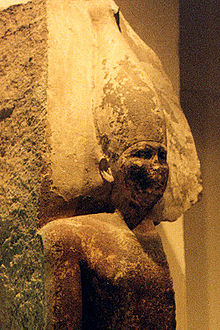Sneferu & Khufu
 |
| Stela depicting 4th Dynasty King Sneferu |
SNEFERU
reigned between c.2613 BC - c.2589 BC and he was the successor and probably the son of King Huni and one of his lesser wives, Meresankh I.
He is thought to have led military campaigns to secure the borders of Egypt, particularly to the south to protect and control the important trade of commodities.
During his reign the final smooth-sided form of the pyramid was perfected. Snofru's first was a step pyramid at Meidum. When Snofru moved his court to Dahshur, in the fifteenth year of his reign, work began on a new pyramid at the site. Its sides at first were very steep, and cracks appeared as the building grew - so its angle of incline was decreased for the higher sections of the construction. This gave it a strange outline - hence the modern name the Bent Pyramid. (pictured below)

A further pyramid was built for the king at the same site, and this is now known as the Red (or Northern) Pyramid. (pictured below) This was Egypt's first true pyramid, and the model on which the more famous structures at Giza were based. It is also thought to be the tomb in which Snofru was finally buried. He was succeeded by his son Khufu, Egypt's best known builder of pyramids. With his impressive building programme it is not surprising that Snofru was deified during the Middle Kingdom.

 |
| Limestone statue of Sneferu, Egyptian Museum |
KHUFU
Furthermore, here's some info on his Sneferu's son, Khufu. Also known by his Greek name, Cheops, the Egyptian pharaoh Khufu was the second pharaoh of the Fourth Dynasty, famous for building the Great Pyramid at Giza.
Khufu's full name was Khnum-Khufwy, which means '[the god] Khnum protect me'. He was the son of Sneferu and Queen Hetepheres I, and is believed to have had three wives. He is famous for building the Great Pyramid at Giza, one of the seven wonders of the world, but apart from this, we know very little about him. His only surviving statue is, ironically, the smallest piece of Egyptian royal sculpture ever discovered: a 7.5 cm (3 inch) high ivory statue found at Abydos. (pictured below)

Khufu came to the throne, probably during his twenties, and at once began work on his pyramid. The entire project took about 23 years to complete, during which time 2,300,000 building blocks, weighing an average of 2.5 tons each, were moved. His nephew Hemiunu was appointed head of construction for the Great Pyramid. Khufu was the first pharaoh to build a pyramid at Giza. The sheer scale of this monument stands as testament to his skills in commanding the material and human resources of his country. It is now believed the pyramids were built using conscripted labour rather than slaves. The idea that Khufu used slaves to build the pyramid comes from Greek historian Herodotus. He also describes Khufu as a cruel and wicked leader who prostituted his daughter when he ran short of money. But the Westcar Papyrus describes Khufu as a traditional oriental monarch: good-natured, amiable to his inferiors and interested in the nature of human existence and magic.
Despite not being remembered as fondly as his father, the funerary cult of Khufu was still followed in the 26th Dynasty, and he became increasingly popular during the Roman period.
 |
| Great Pyramid of Giza |
Information taken from: https://upload.wikimedia.org/wikipedia/commons/e/e3/Kheops-Pyramid.jpg
Comments
Post a Comment